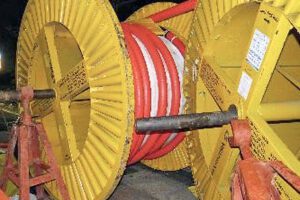The Department of Mines and Petroleum have released a Safety Significant Incident Report after a worker was seriously injured by an explosion of condensate drain line on air booster compressor.
Read the full report below.
SUMMARY OF INCIDENT
Note: The Department of Mines and Petroleum’s investigation is ongoing. The information contained in this significant incident report is based on materials received, knowledge and understanding at the time of writing.
An operator at a dewatering spread was required to drain condensate from a knock-out drum (scrubber), which removes water from the air booster compressor system.
As he actuated the drain valve, hydrocarbon deposits in the high-pressure condensate drain line ignited and the metal line ruptured (see “Further information” for explanation).
The explosion resulted in permanent, debilitating injuries to the operator.
DIRECT FACTORS
• The localised pressure shock wave produced by adiabatic ignition of hydrocarbon deposits in the drain line exceeded the system rating, and pipes and fittings ruptured.
• The operator was positioned next to the drain line when it exploded.
CONTRIBUTORY FACTORS
• The design of the compressor system did not protect against the risk of adiabatic compression:
– use of fast opening valve (sudden pressure differential)
– geometry of condensate line (high-velocity particles impinge on localised area, allowing heat buildup and contributing to adiabatic ignition)
– equipment not earthed (gas flow across the valve trim may have generated a static charge).
• Inappropriate maintenance practices included:
– mixing lubricants with different auto-ignition temperatures
– not addressing the presence of contaminants in the lubricants (dust and fine debris behave as high-velocity particles with kinetic energy transformed into heat upon impact).
ACTIONS REQUIRED
Responsible persons are reminded of the importance of monitoring and reviewing the design, installation and use of plant to ensure workers can undertake tasks safely. The following measures are recommended.
Design considerations
• Confirm the adequacy of design factors of safety for all pipework and receivers connected to systems downstream of a switching valve, including the use of screwed fittings in high-pressure air systems.
– Install remotely operated valves where practicable. If not, consider cracking condensate drain valves in the open position.
• Avoid using fast-opening valves where the risk of adiabatic ignition exists.
• Avoid sharp bends, tees and elbows to minimise the potential for high velocity particles impinging on localised areas.
• Reduce the potential to generate a static charge on fittings.
– Ensure electrical continuity between all parts of the system, especially valves.
– Earth all compressors and boosters in accordance with Australian Standards.
– Consult the original equipment manufacturer (OEM) regarding the suitability of non-metallic system components.
Note: Ball, butterfly and eccentric disc valves have an inherent risk as the grounding path between the trim and valve body is inadequate. Soft-seated valves may produce a static discharge from the rapid relative motion between the disc and seat.
• Using materials with high thermal conductivity will assist in heat dissipation from hot spots.
• Use additional safety devices such as bursting discs to protect against adiabatic ignition.
Note: Pressure relief valves (PRVs) have slow response times and are not designed to protect against adiabatic ignition events.
Operational and maintenance considerations
• Consult with the original equipment manufacturer (OEM) before modifying or changing operating parameters.
• In consultation with operators and maintenance personnel, undertake a formal risk assessment of high-pressure compressed air systems to reduce risk to an acceptable level.
– Review high-pressure air paths for potential “slam-on slam-off” operations that may result in adiabatic ignition events in the system.
• Do not assume that high-pressure air paths are unobstructed.
• Use only OEM-approved lubricants and cleaning agents.
• Lubricants should be clearly labelled to prevent cross-contamination, and operators and maintenance personnel trained in their use.
Note: Mineral oil-based lubricants have a lower auto-ignition temperature than phosphate ester-based lubricants.
• Establish an appropriate maintenance and inspection regime to:
– maintain air intake and oil filters to minimise contamination
– monitor air boosters and compressors for excessive oil loss as well as high discharge temperatures
– identify potential contaminants (e.g. rust and other metal oxides) that can lower the auto-ignition temperature of lubricants
– identify excessive (over)lubrication, which can increase the amount of combustible material in the system.
Note: Higher temperatures promote the occurrence of adiabatic ignition, while higher pressures increase the propagation speed of the shock wave.
FURTHER INFORMATION
What ignited the hydrocarbon deposits in the drain line?
Lubricated air compressors and boosters potentially have the three elements of the fire triangle (oxygen, ignition source and fuel) present at the same time.
When gas collides at great speed with a resistance, the temperature rises very quickly due to adiabatic compression, which is so rapid that the thermal energy cannot dissipate.
In this incident, opening the valve led to adiabatic compression when high-pressure gas injected abruptly into a low-pressure system of reduced volume.
The temperature increase ignited hydrocarbon deposits (any airborne oils and lubricants) and nonmetallic materials once their auto-ignition temperature was reached.














Add Comment